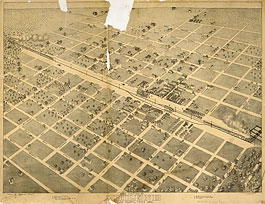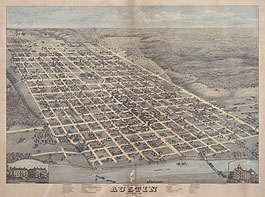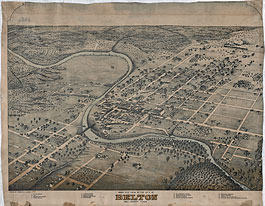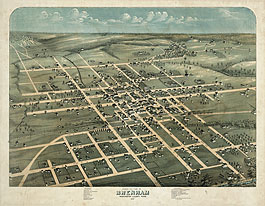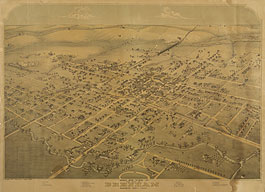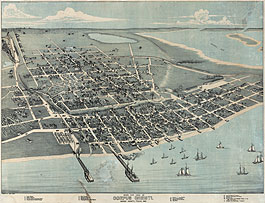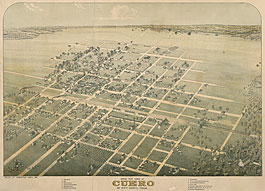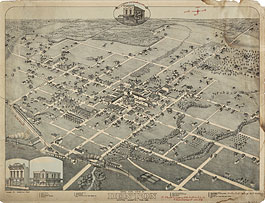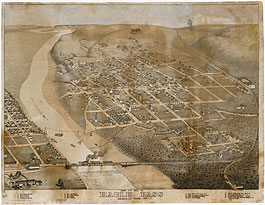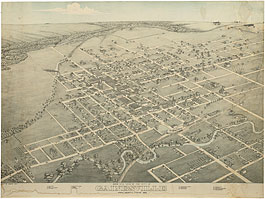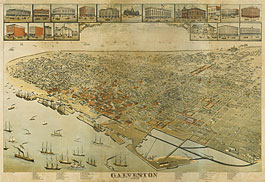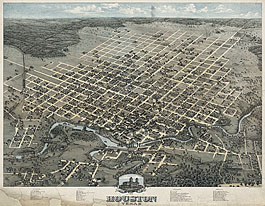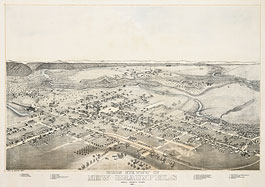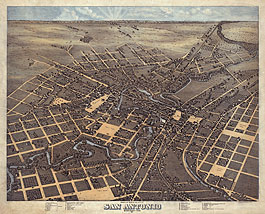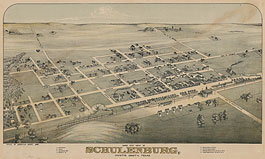Abilene in 1883
Abilene came into being as the Texas and Pacific Railway rapidly built its way from Fort Worth across West Texas. As the railroad industry recovered from the Panic of 1873, New York financier and railroad magnate Jay Gould organized a syndicate to provide new investment muscle for the T&P, and he put engineer and former General Grenville M. Dodge in charge of construction. Work began in Fort Worth on… [More]
Austin in 1873
Austin had been designated the permanent capital of the state just a few months before Augustus Koch, one of the most prolific of the itinerant city-view artists, arrived in town in January 1873, and the city was experiencing a boom. The view that Koch proposed to the editor of the Daily Democratic Statesman would be a tangible expression of the city’s new-found pride as the population grew steadily and… [More]
Austin in 1887
Koch paid a return visit to Austin in 1887. The city was much larger by then—in the ensuing fourteen years, the population almost doubled to well over 11,000—and Koch reflected that in a print even larger than the one he had made of San Antonio. The eye easily traces the new growth in a diagonal line from lower left to upper right: from the reconstructed bridge over the Colorado… [More]
Bastrop in 1887
During what might have been his fourth tour of Texas, Augustus Koch paused to sketch a bird’s-eye view of Bastrop, a small city of approximately 2,000 persons about thirty miles southeast of Austin. The city is located on the east bank of the Colorado River on a bluff that is generally level until it rises gently to form the low hills east of town, home to the remnants of… [More]
Belton in 1881
Located on Nolan Creek, a tributary of the Leon River, Belton, the county seat of Bell County, was a small town of fewer than 1,800 persons when Koch visited in 1881. But the town was already rebounding from the economically disastrous years of the Civil War and a terrible fire of the year before that had destroyed much of the downtown area. The nearby Chisholm Trail, which ran along… [More]
Brenham in 1873
Augustus Koch’s view of Brenham in 1873 shows a city that emerged from the throes of the Civil War and Reconstruction with some confidence that it would continue to prosper. As with other contemporary views, the railroad occupies a significant place in the geography and future of the city. Washington County citizens organized the Washington County Railroad to link with the Galveston and Red River Railway (later the Houston… [More]
Brenham in 1881
The Brenham that Koch depicted in 1881 had been rebuilt since the disastrous 1873 fire had destroyed much of the downtown area, and the railroad had enlarged Brenham’s trade area and stimulated its growth, including a significant immigration from Germany. Between June 1878 and June 1879, for example, more than 100 new houses were built within the city limits, and new businesses and churches were established to serve the… [More]
Corpus Christi in 1887
Although various Indian bands had inhabited the area at the mouth of the Nueces River for centuries, the Spaniards never successfully settled Corpus Christi. Anglo merchants established a trading post there in 1839, following the war between the United States and Mexico, but it did not prosper until the decade of the 1870s, when sheep and cattle ranching became widespread in South Texas, with Corpus Christi as the primary… [More]
Cuero in 1881
Cuero in 1881 was the center of a region of small farmers who raised cotton, corn, sweet potatoes, and livestock. Although there had been a village known as Cuero as early as 1846, the present site of the city was established when the Gulf, Western Texas and Pacific Railway arrived from Indianola and Victoria en route to San Antonio in 1873, and the county seat was relocated from nearby… [More]
Denton in 1883
Denton was established in 1857 to serve as the county seat of Denton County. Anglo-American settlement in the region had begun with the Peters colony grant in 1841, but the community, based on sustenance agriculture, grew slowly until the arrival of the railroads in 1881.The population of the city more than doubled to 2,558 in the ensuing decade. The railroad connections to Sherman, Dallas, and Fort Worth provided farmers… [More]
Eagle Pass in 1887
Augustus Koch’s bird’s-eye view of Eagle Pass is dominated by the Rio Grande on the left side of the picture; the Galveston, Harrisburg and San Antonio Railway at the right and bottom; and Fort Duncan in the lower right-hand corner. An unnamed creek separates the city from the fort.
Eagle Pass began in 1850 when a settlement grew up around Fort Duncan, which had been established the previous year on… [More]El Paso in 1886
Throughout its history prior to 1881, El Paso-area business had been dominated by its location on the north-south Camino Real that connected Mexico City with Chihuahua and Santa Fe. With the arrival of the Southern Pacific Railroad in May 1881, however, the city got a direct rail connection with the West Coast, and when the Southern Pacific connected with the Texas and Pacific at Sierra Blanca the following December… [More]
Flatonia in 1881
The area around Flatonia was settled by Anglo-Americans prior to the Civil War, but inexpensive land gradually brought German, Bohemian, Greek, Arabian, and Italian immigrants into the region. The city itself was created by the Galveston, Harrisburg and San Antonio Railway as it built west through Fayette County from Schulenburg in April 1874. Residents of old Flatonia, one mile southeast of the new site, and Oso, three miles northeast… [More]
Gainesville in 1883
The Gainesville that Augustus Koch depicted in 1883 was a prosperous cattle town, with a large courthouse and public school building financed by income from the cattle business. The first Anglo-American settlers arrived in the area, on the western border of the Eastern Cross Timbers, where “the magnificent roll of the prairie is broken abruptly off against the woody rim,” in the 1840s, and the city was founded as… [More]
Galveston in 1885
Augustus Koch’s view of Galveston in 1885 reveals how much the city had grown in the fourteen years since Camille M. Drie depicted it in 1871. Shown from the northwest, both views focus on the downtown commercial district and the port facilities on Galveston Bay, the narrow strip of water between the mainland and the island. Galveston was the largest city in the state and the third largest cotton… [More]
Gatesville in 1884
As with many cities in the late 1800s, Gatesville was recovering from a fire. The rebuilding had already begun when Koch made this view, and the Texas and St. Louis Railroad, which initiated service from Waco in October 1882, had accelerated growth in this small Central Texas community. Gatesville was primarily a regional agricultural center, with Benjamin Worley’s Flour and Planing Mill and Cotton Gin operating on Still House… [More]
Houston in 1873
Shortly after Texas won its independence on the nearby battlefield at San Jacinto in 1836, Augustus C. and John K. Allen founded Houston at the head of tide on Buffalo Bayou to be the leading metropolis of the new nation. Sam Houston, elected first president of the Republic of Texas, was honored to have the city named after him and considered the site “far superior” to all others for… [More]
La Grange in 1880
Augustus Koch began his second tour of Texas probably in late 1880 with a drawing of La Grange, the county seat of Fayette County. Following Anglo-American immigration into the area in the 1820s, the region had quickly developed a plantation economy built on slavery and the fertile lands along the Colorado River. With increasing German and Wend immigration after the Civil War, the size of farms decreased, but their… [More]
New Braunfels in 1881
In depicting New Braunfels, founded in 1845 under the auspices of the Adelsverein (also known as the Society for the Protection of German Immigrants in Texas), Augustus Koch chose the perspective from the Sophienburg (Fort Sophia), the headquarters that Prince Solms-Braunfels established for the colony. Built on a hill on the south side of the new settlement with a view of the Comal River and its confluence with Comal… [More]
San Antonio in 1873
Unlike most Texas bird’s-eye views, Augustus Koch’s depiction of San Antonio does not include a train, because the railroad did not arrive in the Alamo City until 1877. The most obvious aspects of the city, viewed from the northwest, are its many public plazas and the winding San Antonio River. San Fernando Church is located on the west side of the Main Plaza, with the Bexar County Courthouse immediately… [More]
San Antonio in 1886
The railroads were slow to build to San Antonio. In 1877, Galusha Aaron Grow, president of the International-Great Northern Railway, suggested that San Antonio was “perhaps the largest city on the continent today that had remained so long without railroad connection”—and when railroads did arrive on the evening of February 19, 1877, they transformed the “old dry bones of the Alamo City.”
San Antonians had tried to lure a railroad… [More]San Marcos in 1881
San Marcos was still a small, country town when Augustus Koch documented it in December 1880 shortly after the International-Great Northern Railroad, shown on the right-hand side of the print, connected it with Austin and San Antonio. Anglo-American settlers had arrived at the site in the 1840s, and the city had developed as a regional milling and ginning center. Cattle and cotton had become its main products by 1870… [More]
Schulenburg in 1881
Schulenburg, located in southern Fayette County about eighteen miles south of La Grange, was a small town of fewer than 1,000 persons when Koch visited in 1881. It had been founded in 1873, when the Galveston, Harrisburg and San Antonio Railway built through that portion of the county, and was settled by German, Austrian, and Czech immigrants whose presence is documented in some of the street names such as… [More]











